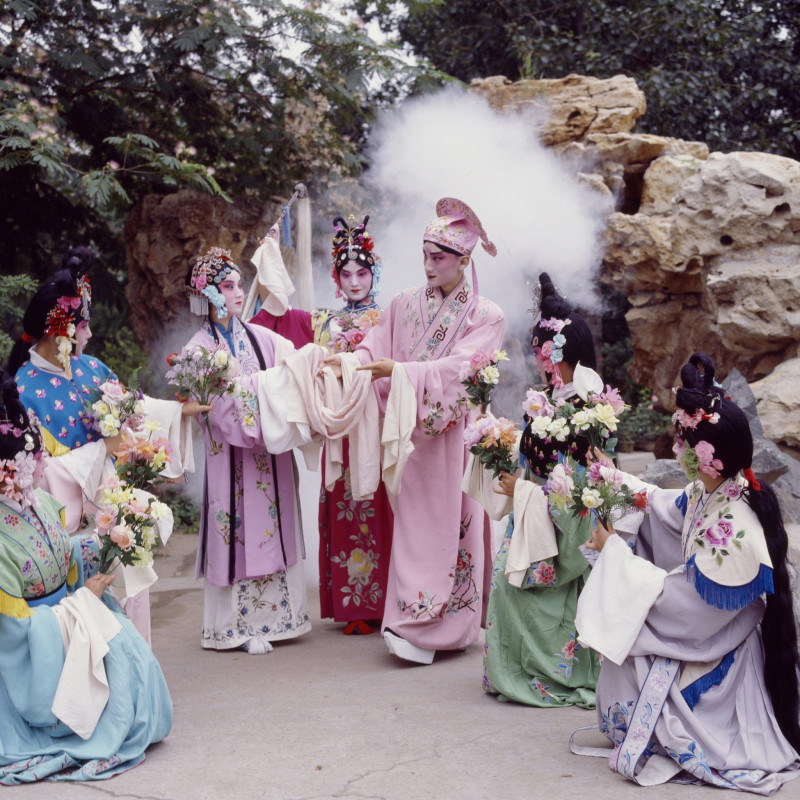Traditional Chinese calendar paintings are an old genre that was most popular amongst the working class. During Spring Festivals, the changing of the calendar was an event in itself, adding cheer to the holiday atmosphere. Simple and accessible, the content of calendar paintings included supernatural stories, great beauties, children, folk legends and customs. Within this genre, paintings of Chinese opera were especially loved by both city-dwellers and peasants alike. Taking advantage of opera's visual appeal and the mass-production of woodcut printing, the paintings took the repertoire of operas known in every household and told them through the form of calendar paintings.
Vintage pin-up posters developed from the traditional calendar paintings during Republican China, borrowing Western painting techniques and adopting modern printing methods to create a very distinctive look. After 1949, calendar painting was placed on equal footing with other art forms such as ink painting, oil painting, and prints. During the ten years of the Cultural Revolution, however, calendar paintings were suppressed, and nearly eliminated, because their content was considered part of the 'Four Olds' and 'Feudal Dregs.' After the Opening and Reform, and following the Chinese countryside's economic development, the people's demand for calendar paintings quickly grew. In order to supply the market, large domestic publishing houses started to use modern technology to mass-produce calendar paintings. From the seventies to the early nineties, calendar paintings enjoyed a renaissance, and in the process changed much in content, form, and material from traditional calendar painting. However, following society's economic and cultural changes, calendar paintings today are steadily disappearing.
Mr. Wang Binglong graduated from the Beijing Central Academy of Fine Arts' High School, and then worked as an artist and photographer for the Central News and Film Production Studio. In the late seventies, he presided over artwork at the China Opera Publishing Company, while developing his skills as a well-known illustrator. In the beginning of the Opening and Reform period, art, opera, and other genres were just coming back to life after many years of suppression. People welcomed Chinese opera calendar paintings once again. From movie posters and opera stage pictures, a photographic form of opera calendar paintings emerged and started to appear on the market. At that time, this kind of work was always taken on stages or sets, with backgrounds relatively dark and characters rigidly adhering to operatic poses. Mr. Wang Binglong created a new model of calendar photography that left the stage and sets, and placed opera performers in natural environments. The bright, innovative pictures were a great success, and the model was soon followed by many other photographers, creating a new art genre.
In the process of taking these pictures, Mr. Wang Binglong played the roles of producer, director, photographer, and writer all in one. He read opera scripts, selected chapters, created characters, costumes, and props, then managed the outdoor settings, performance of the actors, and picture composition. In his ten years of work, Mr. Wang has traveled all over the country, taking over 1,000 negatives and covering the operatic works of all corners of the China. These visual images have become an important resource for the research of China's opera.
For today's eyes, Mr. Wang Binglong's opera calendar photography is an art form produced of a unique historical period. It was not only a contemporary expression of common calendar paintings, but a kind of deep visual creation. The works' mastery of invented elements and exploration of an image's strength provides a valuable reference point for contemporary photography. In fact, the still film style of shooting so popular in contemporary photography today was natural in Wang Binglong's early work.
As an organization that explores, arranges, and researches Chinese contemporary photography, the Three Shadows Photography Art Centre is pleased to present Mr. Wang Binglong's solo show '1979-1989: Chinese Opera Calendar Photography.’
The exhibition is an opportunity for contemporary eyes to examine this unique photographic creation from twenty years before, analyze its place in the course of contemporary art history, and make an inquiry into its value and contribution to contemporary Chinese photography.






